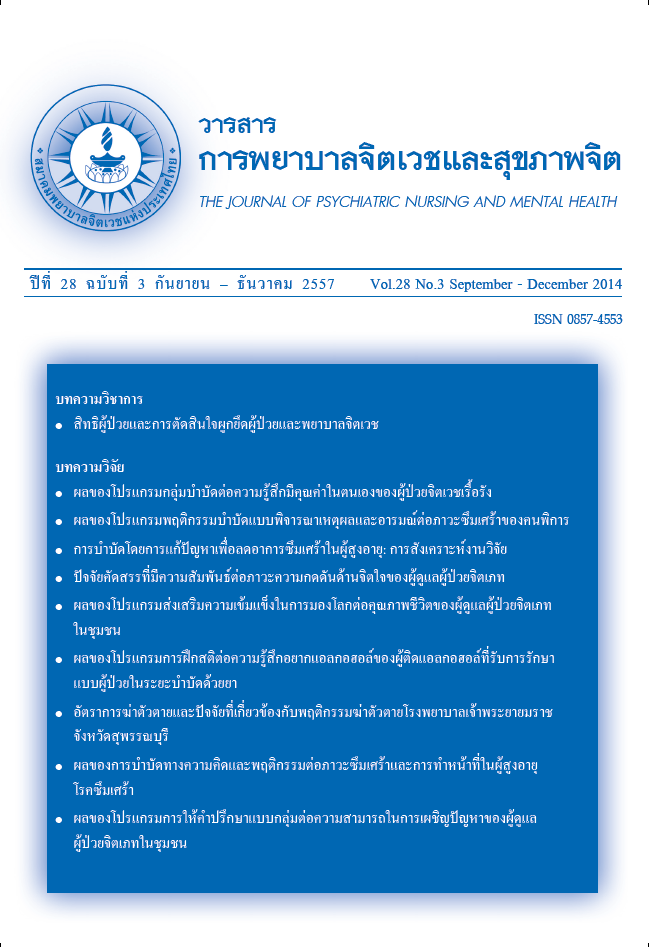การบำบัดโดยการแก้ปัญหาเพื่อลดอาการซึมเศร้าในผู้สูงอายุ: การสังเคราะห์งานวิจัย PROBLEM-SOLVING THERAPY FOR REDUCING DEPRESSIVE SYMPTOMS IN OLDER ADULTS: SYNTHESIS OF RESEARCH STUDIES
Main Article Content
บทคัดย่อ
วัตถุประสงค์: เพื่อสังเคราะห์งานวิจัยเกี่ยวกับการบำบัดโดยการแก้ปัญหาเพื่อลดอาการซึมเศร้าในผู้สูงอายุ
วิธีการศึกษา: สืบค้นงานวิจัยจากฐานข้อมูลที่เชื่อถือได้ แล้วนำมาประเมินคุณภาพและระดับความน่าเชื่อถือ ได้งานวิจัย 7 เรื่อง เป็น Systematic Review 1 เรื่อง และ Randomized Controlled Trial 6 เรื่อง
ผลการศึกษา: พบว่าโปรแกรมการบำบัดแบบประสานความร่วมมือ (IMPACT) ซึ่งประกอบด้วยการบำบัดด้วยยาต้านเศร้า และการบำบัดโดยการแก้ปัญหา (PST-PC) มีประสิทธิภาพในการลดอาการซึมเศร้าในผู้สูงอายุในระดับปฐมภูมิ ผู้รับการบำบัดมีอายุตั้งแต่ 60 ปีขึ้นไป ได้รับการวินิจฉัยว่าเป็นโรคซึมเศร้ารุนแรงหรือเรื้อรัง รูปแบบการบำบัดมีดังนี้ 1) คัดกรองและให้ความรู้เกี่ยวกับโรคซึมเศร้า 2) เริ่มการบำบัดช่วงแรก(8-12 สัปดาห์) ผู้รับการบำบัดเลือกว่าจะรับการรักษาด้วยยาต้านเศร้าหรือ PST-PC และประเมินอาการซึมเศร้าหลังสิ้นสุดช่วงแรก ถ้าอาการลดลงจะเข้าสู่กระบวนการป้องกันการกลับเป็นซ้ำ แต่ถ้าไม่ จะเข้าสู่ช่วงสอง 3) การบำบัดช่วงที่สอง (6-10 สัปดาห์) ปรับแผนการบำบัด โดยอาจเปลี่ยนยาตัวใหม่ เพิ่มขนาดยา เปลี่ยนจากยาเป็น PST-PC เปลี่ยนจาก PST-PC เป็นยา หรือใช้ทั้งสองอย่างร่วมกัน แล้วประเมินอาการซึมเศร้า ถ้าลดลงจะเข้าสู่การป้องกันการกลับเป็นซ้ำ แต่ถ้าไม่ จะเข้าสู่ช่วงสาม 4) การบำบัดช่วงที่สาม (6-12 สัปดาห์) ปรับแผนการบำบัดใหม่ หรือส่งต่อเข้ารับการรักษาในโรงพยาบาล เพื่อให้การบำบัดอื่นที่ไม่มีในระดับปฐมภูมิ
สรุป: ควรพัฒนาแนวปฏิบัติการพยาบาลให้มีความเหมาะสมกับบริบทของหน่วยงานก่อนนำข้อแนะนำไปใช้
Objective: To examine research-based evidence on problem-solving therapy to reduce depressive symptoms in older adults.
Methods: The evidence was searched from reliable databases. Each was then evaluated for its quality and strength. Seven studies met the selection criteria: one systematic review and six randomized controlled trial studies.
Results: The effective program to reduce depressive symptoms in older adults in primary care is the collaborative treatment program called "IMPACT" which incorporates the useof antidepressant medication (AD) and problem solving therapy (PST-PC). The clients were adults ages 60 years and above with the diagnosis of major depressive disorder or dysthymia. The program processes were as follows. 1) Clients were screened for depression; then, knowledge about late-life depression was provided. 2) In the initial treatment phase (8-12 weeks), clients selected their choices of treatment either AD or PST-PC. At the end of the phase, depressive symptoms were assessed. If the symptoms decreased, a relapse prevention plan would be developed. If not, clients would proceed to the second phase. 3) In the second phase (6-10 weeks), the treatment plan could include switching to a different AD, augmenting a dosage of AD, switching from AD to PST-PC, or vice versa, or a combination of both. Then, depressive symptoms were reassessed. If the symptoms decreased, a relapse prevention plan would be developed. If not, clients would proceed to the third phase. 4) In the third phase (6-12 weeks), the treatment plan was reviewed and adjusted, or admission to the hospital for additional treatment not available at the primary care level was considered.
Conclusion: A clinical nursing practice guideline should be developed prior to implementing the recommendations in the practice setting.
Article Details
บทความที่ได้รับการตีพิมพ์แล้ว เป็นลิขสิทธิ์ของสมาคมพยาบาลจิตเวชแห่งประเทศไทย


